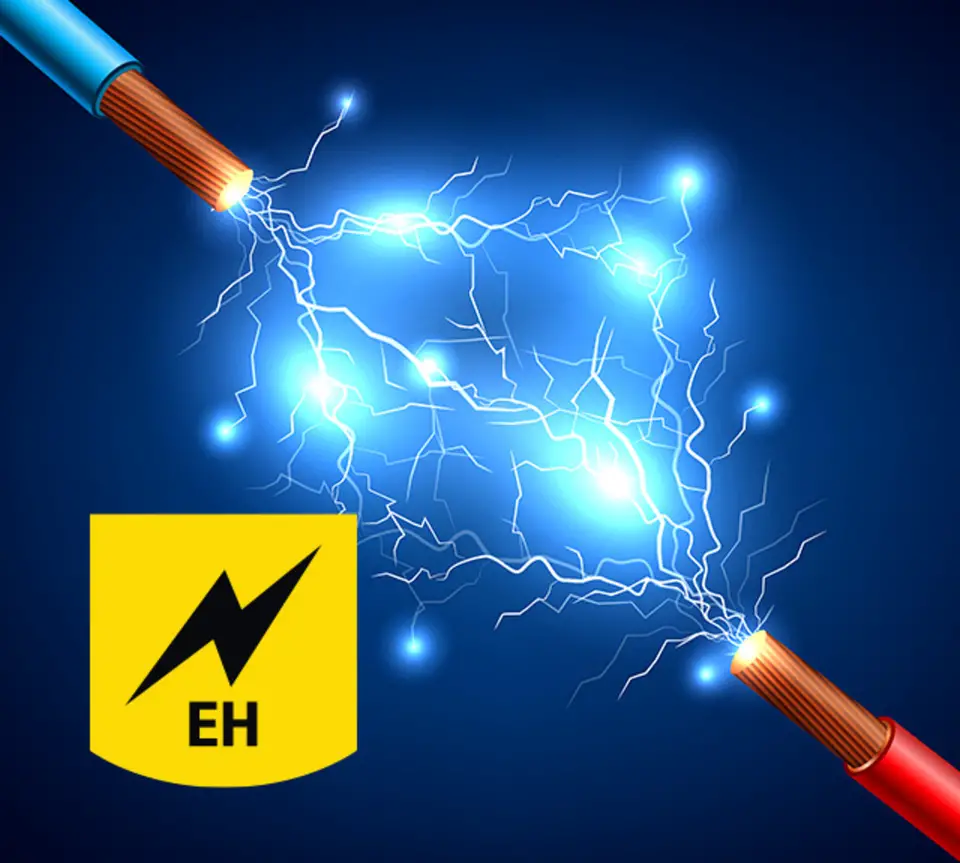While there are innumerable work hazards at our workplace, electricity still continues to be a grave danger. Every single day professionals like engineers, electricians and other maintenance workers have to deal with electricity on a daily basis knowing that even a few milliamps can cause harm to their bodies.
 These professionals who are well aware of the consequences of dealing with electricity take as many precautions as they can. However, the power is invisible and can sometimes be left exposed in places like construction sites in the form of naked electrical cables. That is why footwear security becomes an essential part at the work site.
These professionals who are well aware of the consequences of dealing with electricity take as many precautions as they can. However, the power is invisible and can sometimes be left exposed in places like construction sites in the form of naked electrical cables. That is why footwear security becomes an essential part at the work site.
The Electrical Hazard boots or popularly called EH boots are especially designed non-conductive footwear which inhibits your feet from completing an electrical circuit to the ground. They have an EH rating on them which ensures these are tested by American Society for Testing and Materials (ASTM) for their protection against electrical shock.
These boots are tested and approved by the American Society for Testing and Materials (ASTM) and are designed using non-conductive materials which make you fully isolated stopping the current to pass through it.
This article is about all the information on EH boots, their standard requirements and what all these boots take into consideration to save you from the aforementioned hazards of the job. We will also burst some of the myths that people have with regard to these boots.
What are Electrical Hazard Boots?
The concept behind the construction of the Electrical Hazard rated boots is pretty simple. The entire surface of these boots are made of non-conductive material which do not allow the electrical charge to surpass the body because you are fully isolated from the ground.
The boots significantly put a stop to the flow of electricity through them and then into the ground. Interestingly, the footwear inhibits electrocution just in case you mistakenly step on a live wire.
A very basic feature of these boots is the presence of thick insulated soles which are very durable. The Eh boots come with added features like abrasion, water and slip resistance to save you from falls and slips while working.
What are the standard requirements for EH boots?
For getting a proper certification, electrical hazards bots should meet some specific criterias. The American Society for Testing and Materials has laid two section of rules to ensure that EH boots meet the correct standards which are:
-
-
- The ASTM F2412-11, Standard Specification for Performance Requirement
- The ASTM F 2413-11, Performance Requirement for Protective Toe Cap Footwear
-
ASTM F2413-11
This section is specially designed for a footwear to meet the minimum requirement needed for performance, testing, design and classification. To get this certificate, a footwear should have following features:
-
-
- Proper impact resistance section
- Compression resistant section
- Metatarsal protection
- Electric Hazard protection
- Conductive protection
- Puncture protection
-
Other exciting features which are possessed by EH rated boots to protect from electrical hazards are
-
-
- Insulation tested in production for 1 minute at 18,000, 60Hz
- Outsoles made in specific insulating rubber or PU compound
-
What are OSHA guidelines for EH boots?
As per Occupational Safety and Health Administration (OSHA), the electrical hazard boots should be able to withstand 18000 volts of electricity at 60 Hz for a whole minute without leakage of more than one milliampere under dry conditions.
OSHA letters of interpretation have presented EH shoes positively. In areas which possess higher risks, OSHA demands ASTM F1117. According to OSHA, “Electrical hazard, safety-toe shoes are non conductive and will prevent the wearers’ feet from completing an electrical circuit to the ground.
These shoes can protect against open circuits of up to 600 volts in dry conditions and should be used in conjunction with other insulating equipment and additional precautions to reduce the risk of a worker becoming a path for hazardous electrical energy.
The insulating protection of electrical hazard, safety-toe shoes may be compromised if the shoes become wet, the soles are worn through, metal particles become embedded in the sole or heel, or workers touch conductive, grounded items.
Note: Non Conductive footwear must not be used in explosive or hazardous locations.”
How are EH boots different from Static Dissipating (ESD) Boots?
Static Dissipating safety shoes conduct electricity through insole, lining, cement, outsole and in the ground. These are different from EH boots in following ways:
| Electric Hazard (EH) Safety Boots | Static Dissipating (ESD) Boots | |
| Function | Designed to reduce the flow of electricity passing through the shoes and ground. | Designed to minimize the amount of static electricity build-up on your body. |
| Safety factor | Must provide protection to your feet | Can either be safety or non-safety shoes. |
| ASTM Label | Always have “EH” on the ASTM label | Clearly mentions “SD” on the ASTM label |
| Level of protection | Not the main but secondary source of protection in an electrical hazard environment. | Primary source of protection |
| Areas of use | Mainly in Electrical Hazard environments like construction sites, electrical sites etc | Chiefly worn in computer component handling facilities, processing plants and manufacturing facilities. |
Bursting Myths about EH boots
A common misconception about work boots which are constructed for working around places with electrical risk is that they should not have metal in them. Well, it’s not true. Metal only conducts electricity when it comes in contact with other metal bodies.
In case of EH rated boots, the construction is done using steel or composite safety toes which have a leather, rubber and other forms of insulation surrounding them. Therefore these boots are quite safe to work in an area of electrical hazards.
Top 3 Electrician Boots
If you are confused about which boots you should buy then here are top 3 boots available in the market
1. Timberland Pro Men’s Powerwelt Wellington Boot
- Pull-on construction and aggressive tread design
- Shaft measures approximately Mid-Calf from arch
- Boot opening measures approximately 15 around
Prices pulled from the Amazon Product Advertising API on:
Product prices and availability are accurate as of the date/time indicated and are subject to change. Any price and availability information displayed on [relevant Amazon Site(s), as applicable] at the time of purchase will apply to the purchase of this product.
Timberland’s Wellington boots are surely one of the most sorted electrical boots in the market. Designed for reliable performance as an electrician work boots, these boots are versatile and can be used in almost all kinds of working environments.
The durability of these boots are reflected in them as these are equipped with sturdy upper which is constructed using heat-resistant Ever-Guard leather which is stronger in comparison to any other leather.
Talking about the safety, the Powerwelt boots have steel toes which promise to save you from hazardous compression and impact in a tough electrical work environment.
Not just this, the dedicated treaded soles enable secure grip and maintain your balance at the workplace. Moreover, the oil and water resistant body ensures that you can work in wet conditions.
Pros:
-
-
- Constructed from high quality waxed full-grain leather with rubber soles.
- Nylon mesh lining which enhances overall freshness and breathability.
- Steel toe caps and steel shank for protection
- Oil and slip resistance.
-
Cons:
-
-
- Not the most comfortable boots in the market
- Take a little more time to break in.
-
2. Keen Utility Men’s Davenport Work Boot
- Composite Toe
- Waterproof
- Traction: oil- and Slip-Resistant
- Insulated & non-metallic
- Electrical Hazard (eh)-rated footwear
Prices pulled from the Amazon Product Advertising API on:
Product prices and availability are accurate as of the date/time indicated and are subject to change. Any price and availability information displayed on [relevant Amazon Site(s), as applicable] at the time of purchase will apply to the purchase of this product.
Packed with all the essential features, these boots are constructed entirely from durable synthetic material with a sturdy rubber sole. Davenport work boots meet or exceed two ASTM electronic hazard standards.
The toe is made of composite material and is lighter in comparison to steel toes. The boots are equipped with oil-resistant properties to save you from accidental falls at the workplace. The presence of breathable waterproof lining keeps your feet dry and fresh.
Moreover, the rubber outsoles save you from slipping and provide impressive traction. The heavy insulation of these boots is really impressive which is around 400 grams of convenient non-metallic insulation when you have to work in cold weather.
Pros:
-
-
- Equipped with 400 grams of non-metallic insulation
- Oil and water resistance
- The micro-cleat tread design provides great traction
- Meets or exceeds ASTM EH rating guidelines
-
Cons:
-
-
- Takes time to break in
- Not very breathable
-
3. Caterpillar Men’s Second Shift Steel Toe Work Boot
- Ankle-cut work boot with steel toe with padded ankle and oil-resistant outsole
- Shaft measures approximately 6 from arch
- Heel measures approximately 1.25
- Platform measures approximately 0.75
- 100% Leather
Prices pulled from the Amazon Product Advertising API on:
Product prices and availability are accurate as of the date/time indicated and are subject to change. Any price and availability information displayed on [relevant Amazon Site(s), as applicable] at the time of purchase will apply to the purchase of this product.
The boots are constructed with a nubuck leather upper or full grain leather. The ASTM rating of these boots is ASTM F2413-18 1/75 EH. The EH rating in these boots ensures that you are protected from approx 14,000 volts of current in a minute.
To help you tackle compression and impact, these boots come with strong and sturdy steel toes. Talking about the durability, the integrated Goodyear Welt construction adds traction and flexibility to the boots and makes them long lasting.
Not just this, the steel shank of the boots enhances stability and makes them firm and steady. Moreover, the T3 rubber outsole gives very impressive traction and makes them slip resistant.
Pros:
-
-
- Have EH standards for safety
- Breathable and comfortable Climasphere insole
- Padded ankle and steel toe for ultimate protection
-
Cons
-
-
- Make your feet sweaty and stinky
- Not very comfortable
-
Final Thoughts
If you are working in an industry full of electrical hazards then I am sure you have accepted danger as the part of your job. You also know how important it is to have the right attire at your job.
While EH rated boots are a secondary source of protection, it is always advisable to look for primary and proper safety gear and then work without any tension.







